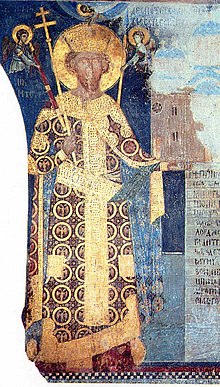Despot Stefan
| Stefan Lazarević | |
|---|---|
| Despot of Serbia | |

|
|
| Reign |
Knez (1389–1402) Despot (1402–1427) |
| Predecessor | Lazar of Serbia |
| Successor | Đurađ Branković |
| Born | 1377 Kruševac, Moravian Serbia |
| Died | 1427 Glava, Serbian Despotate |
| Burial | Manasija Monastery |
| House | Lazarević |
| Father | Lazar of Serbia |
| Mother | Princess Milica of Serbia |
Stefan Lazarević (Serbian: Стефан Лазаревић, c. 1377–19 July 1427), also known as Stefan the Tall (Стеван Високи), was the ruler of Serbia as prince (1389-1402) and despot (1402-1427). The son of Prince Lazar Hrebeljanović, he was regarded as one of the finest knights and military leaders in Europe. After the death of his father at Kosovo (1389), he became ruler of Moravian Serbia and ruled with his mother Milica (a Nemanjić), until he reached adulthood in 1393. Stefan led troops in several battles as an Ottoman vassal, until asserting independence after receiving the title of despot from the Byzantines in 1402. Becoming an Hungarian ally in 1403–04, he received large possessions, including the important Belgrade and Golubac Fortress. He also held the superior rank in the chivalric Order of the Dragon. During his reign there was a long conflict with his nephew Đurađ Branković, which ended in 1412. Stefan also inherited Zeta, and waged the war against Venice. Since he was childless, he designated his nephew Đurađ as heir in 1426, a year before his death.
On the domestic front, he broke the resistance of the Serbian nobles, and used the periods of peace to strengthen Serbia politically, economically, culturally and militarily. In 1412 he issued the Code of Mines, with a separate section on governing of Novo Brdo – the largest mine in the Balkans at that time. This code increased the development of mining in Serbia, which has been the main economic backbone of Serbian Despotate. At the time of his death, Serbia was one of the largest silver producers in Europe. In the field of architecture, he continued development of the Morava school. His reign and personal literary works are sometimes associated with early signs of the Renaissance in the Serbian lands. He introduced knightly tournaments, modern battle tactics, and firearms to Serbia. He was a great patron of the arts and culture by providing shelter and support to scholars, and refugees from neighboring countries that have been taken by the Ottomans. In addition, he was himself a writer, and his most important work is A Homage to Love, which is characterized by the Renaissance lines. During his reign the Resava School was formed.
...
Wikipedia
